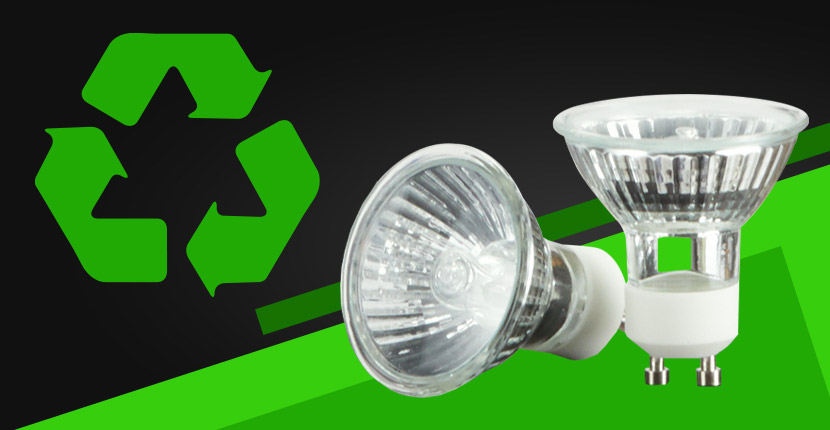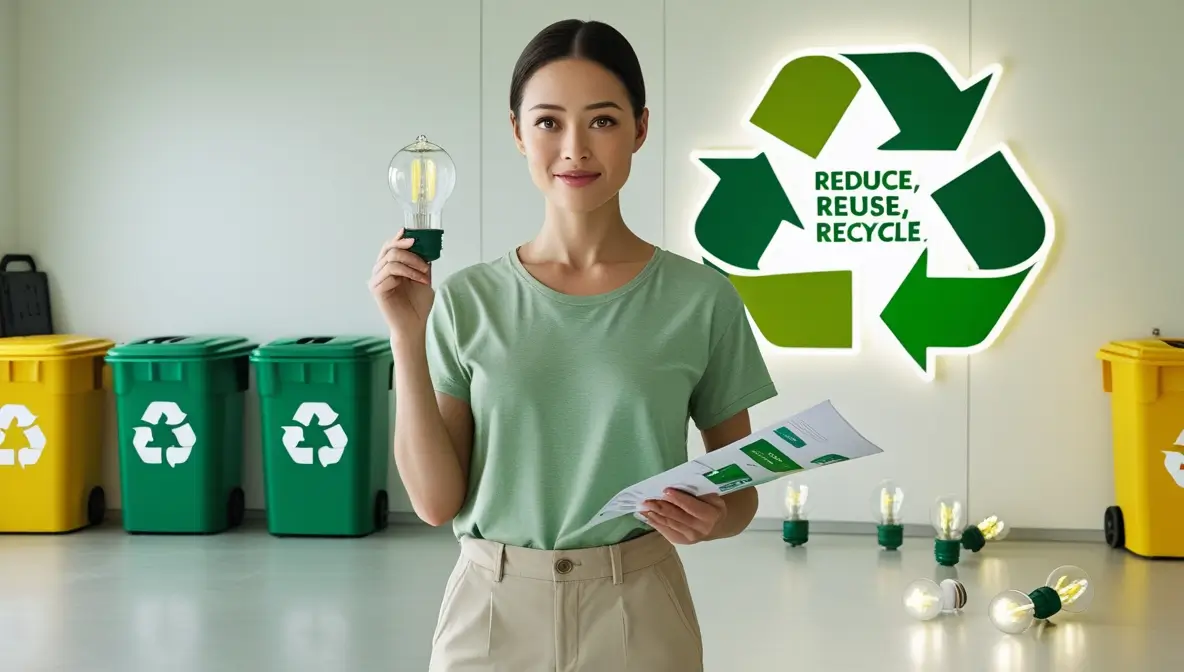How Do I Dispose of Halogen Bulbs safely? Learn proper disposal methods, recycling options, and eco-friendly tips to protect workers and the environment. ✅ Disposing of halogen bulbs can seem tricky. You can’t just throw them in the trash.
Proper disposal is important to avoid harm to the environment. Halogen bulbs contain small amounts of hazardous materials. Improper disposal can lead to these materials leaching into the soil or water. This can cause environmental damage and health risks. So, what do you do with your old halogen bulbs?
There are specific steps to follow. This ensures they are disposed of safely and responsibly. In this blog post, we will explain these steps in a simple, easy-to-follow guide. By the end, you will know exactly how to handle your old halogen bulbs.
Introduction to Halogen Bulbs
A halogen bulb is a special type of incandescent light bulb. Inside them is a tungsten filament that glows with light when hot. While regular incandescent light bulbs just burn a wire inside to produce light, halogen bulbs contain halogen gas (like iodine or bromine) within the bulb. This gas enhances the efficiency of the bulb by boosting the light output and making it last longer.
Halogen bulbs give off a bright, crisp light, which makes them great for several uses. They are commonly found in:
- Home lighting: Halogen bulbs come in a variety of indoor lighting applications including lamps and overhead fixtures.
- Petroleum lamps: For operating petroleum lamps the bulbs help give light to the lantern.
- Work lights and projectors: These bulbs serve you with strong lighting, which can be helpful in work settings and in projectors for bright, sharp graphics.
- Outdoor security lights: Halogen bulbs are also commonly used in security lighting, as their bright illumination helps to improve visibility surrounding a building or outdoor space.
Why Safe Disposal Matters
Although halogen bulbs are effective and efficient light sources, they do have environmental and safety risks when not disposed of correctly:
- Noxious Chemicals: Halogen bulbs do contain minute quantities of noxious chemicals such as halogen gas, and in some cases small amounts of mercury, although the latter is more common in fluorescent-type bulbs, such as CFLs. If a halogen bulb is broken or not properly disposed of, the chemicals can seep into the ground and water and pollute the environment and endanger wildlife.
- Slow Decomposition: The casing of halogen bulbs is made of glass, which is durable, but it takes years to decompose naturally. Bulbs tossed unsafely can add to long-term issues with waste, especially when it comes to landfills.
- Physical Danger: In addition, broken halogen bulbs can be a physical danger in the form of sharp pieces of glass. For another, the chemicals inside a broken bulb could leak, creating an even greater risk of injury or contamination. These irritants can be harmful if ingested or come into contact with skin.
- Environmental Pollution: Halogen bulbs can cause pollution if not discarded properly. These include soil and water pollution that could impact plants and animals that rely on these supplies. Avoiding disposing of hazardous waste such as halogen bulbs into the environment leads to a healthier planet.
How to Prepare Halogen Bulbs for Disposal
Halogen bulbs cannot be recycled and must be disposed of with regular household waste. To safely dispose of the jar and avoid accidents, however, follow these guidelines:
- Wrap the Bulb: It’s a good idea to wrap the bulb in newspaper or a similar protective material to avoid breakage and injury. This keeps any possible shards contained in case the bulb breaks.
- Put in Household Waste: The bulb can then go in your general household rubbish after wrapping. Do not put halogen bulbs in your recycling bin, as they are not recyclable.
Safety Precautions
If you are handling halogen bulbs, you have to take safety precautions to prevent yourself from getting hurt:
- Use Gloves: Handle halogen bulbs with care and always use gloves. Gloves also help prevent cuts from broken glass.
- Power Off: Never attempt to remove or replace a halogen bulb without first turning off the power. That also prevents the risk of electric shock and injury.
- Use a Plastic Bag Once the bulb is out, put it in a plastic bag so that you don’t have to touch any sharp edges. The bag will hold any small glass pieces if the bulb breaks.
- Seal the Bag: after it gets into the plastic bag, seal it. Glass shards don’t pour out to hurt you or other people.
- Keep Halogen Bulb Away from Children and Pets Halogen bulb, if broken, should not be within the reach of children and pets, so ensure that you store them at a place which is out of reach of children and pets.
Handling Broken Bulbs
prompt and cautious action must be taken to safely clean up if a halogen bulb breaks:
- Use a Broom and Dustpan: When cleaning up shards, don’t use your hands Use a broom and dustpan to sweep up all the pieces instead.
- Step 2: Seal the Pieces Place the broken pieces into a strong, sealed plastic bag. This is to avoid cuts from broken glass and to keep the surrounding area also safe.
- Bagging the Glass: Bag the glass and label the bag That guarantees whoever handles it will be careful.
- Dispose as Hazardous Waste: Do not put broken halogen bulbs in the regular trash. They are to be thrown away as hazardous waste. Most municipalities have designated drop-off sites or facilities for safe disposal of the items, such as broken bulbs, to be recycled or disposed of properly.
Local Disposal Regulations
Halogen bulbs should be washed or stored safely with other glass waste, in accordance with local regulations, if glass recycling is available. Here’s how to dig up the correct information:
- Consult Your City’s Website: Government websites often have individual instructions for area residents when it comes to disposing of halogen bulbs and other hazardous materials. Look up disposal regulations for lightbulbs, and be mindful of any specific guidelines.
- Follow Local Disposal Rules: Some locations have more specific disposal instructions, so ensure you are following them. This can help avoid accidentally being environmentally harmful, as well as assist local waste management processes.
- Hazardous waste programs: cities often have programs for hazardous waste, including halogen bulbs. These programs enable residents to take hazardous materials to specific locations for appropriate treatment and recycling.

Recycling Halogen Bulbs
While halogen bulbs aren’t usually recyclable via curbside recycling bins, there are other ways to make sure they’re thrown away responsibly:
- Some recycling centers take halogen bulbs. These centers are set up for hazardous waste, such as light bulbs, and they will make sure these materials are disposed of properly. Contact your local center for specific instructions or specific bins for light bulbs.
- Store Take-Back Programs: Many larger stores have bulb take-back programs. These stores collect old light bulbs, including halogen ones, and ship them to a recycling facility. Just ask your local store if they provide this service. It is a simple method to recycle your bulbs and make sure the environment is safe.
Alternative Disposal Methods
If you don’t have local options, halogen bulbs can also be recycled through other means:
- Mail-in recycling: A number of companies have mail-in programs for light bulbs. Using special packaging, you can send in your old halogen bulbs and the company handles the recycling of them. An easy option, especially if there are no local facilities. Be sure to follow any packaging tips to avoid breakage in transit.
- Hazardous Waste Collection Events: Some communities offer special hazardous waste events during which residents can bring in items such as halogen bulbs. Such events tend to take place several times a year. Visit your local government’s website to find out what’s planned and how you can be involved.
Eco-friendly Lighting Alternatives
Energy-efficient bulbs are a smart choice. They save money and are better for the planet. These bulbs use less power and last longer.
LED bulbs are very efficient. They use up to 80% less energy than halogen bulbs. LED bulbs also have a much longer lifespan. This means fewer replacements and less waste.
Another benefit is that LED bulbs do not get hot. This makes them safer to use. They also come in many shapes and sizes, fitting any space.

Credit: www.batteriesplus.com
Frequently Asked Questions
Can You Recycle Halogen Bulbs?
Yes, halogen bulbs can be recycled. Many recycling centers accept them. Check local recycling programs for specific instructions.
Are Halogen Bulbs Hazardous Waste?
No, halogen bulbs are not classified as hazardous waste. However, they should be disposed of properly to avoid environmental harm.
Where Can I Dispose Of Halogen Bulbs?
Dispose of halogen bulbs at recycling centers or hazardous waste collection sites. Avoid throwing them in regular trash bins.
Can I Throw Halogen Bulbs In The Trash?
It’s not recommended to throw halogen bulbs in the trash. They can break and cause harm. Use proper disposal methods.
Conclusion
Proper disposal of halogen bulbs is crucial for safety. Always handle them carefully. Contact local recycling centers for disposal options. Never throw them in regular trash. Follow guidelines to avoid harm. Clear steps make the process easy. Protect the environment by disposing of bulbs correctly.
Keep your home safe from potential hazards. Stay informed about safe disposal practices. Make responsible choices for a better future. Your efforts help maintain a clean and safe community. Dispose of halogen bulbs the right way.

My name is Mahi Uddin, and I’m a blog writer with over two years of experience specializing in creating engaging, informative content using AI tools. I contribute to InExDecor.com, where I share creative ideas and practical tips for transforming interior and exterior spaces into beautiful, functional environments. With a passion for storytelling and a knack for blending creativity with technology, I strive to craft blogs that not only inform but also inspire readers. When I’m not writing, you can find me exploring design trends or enjoying a good book with a cup of coffee.








